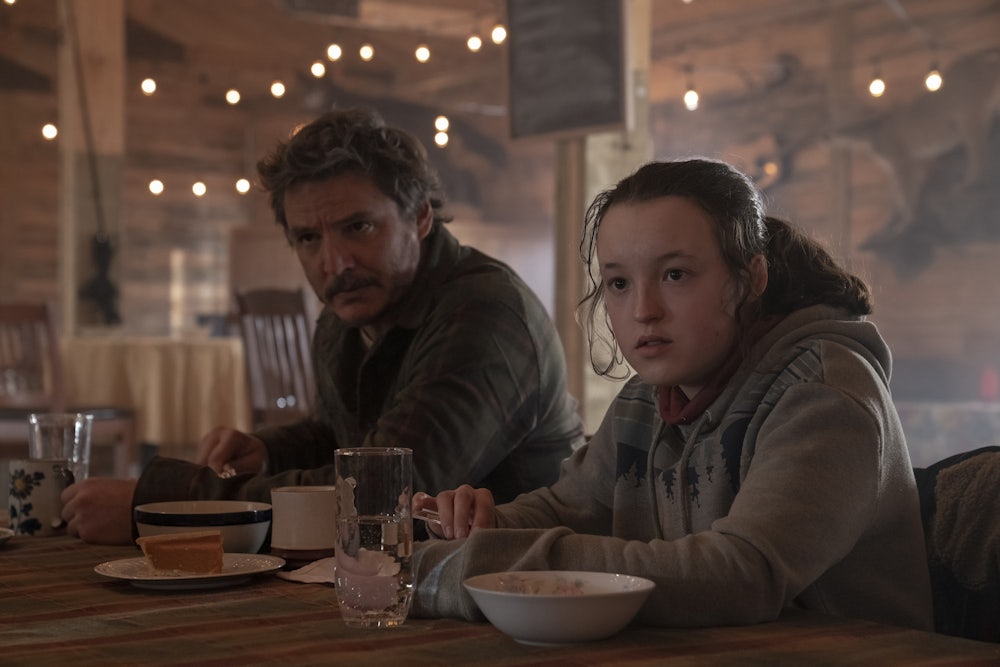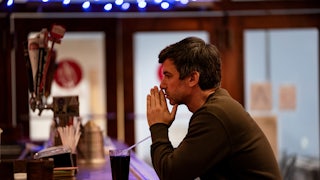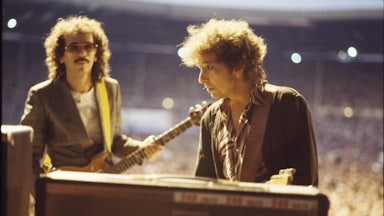A survivalist traps a man in a hole. The survivalist is leery, but he agrees to bring the man into his heavily fortified home for food and shelter. They are, it turns out, both survivors of a plague. The survivalist cooks the man dinner, they play the piano, they share a kiss, they sleep together. Soon, they grow old. They suffer, they heal, they find peace in each others’ arms until their last breaths. It’s a bit maudlin, sure, but it’s also moving. The story of these men and their life together is not the core narrative, not the emotional center, but a momentary digression in HBO’s new series The Last of Us. It’s also one of the most celebrated television episodes of the year.
In some ways, it’s miraculous that such a gutting joint biography could be unfolded in one midseason episode of a series that’s otherwise mostly about blasting the heads off of zombies. Yet it’s also unusually frustrating: By the next episode, the show has moved on as if the lovers never existed. As quickly as the story builds, it is abandoned. The Last of Us, like an increasing number of new TV series, travels light and moves quickly. It keeps what it needs and loses what it doesn’t—which is quite a lot.
In its brisk, unsentimental sentimentality, The Last of Us embodies a booming trend in serial television. For two decades, length was the hallmark of prestige TV. The post-Sopranos serial drama dealt with compelling and complex multiseason narratives, meaty roles for great actors, creative freedom for writers and filmmakers, byzantine plots, and puzzle boxes that relied on viewers to pick up the narrative pieces week to week. On premium cable and later streaming, there wasn’t much of a place for the case-of-the-week episodic series like Law and Order or even House, M.D. Yet recently, the landscape has shifted: TV series with planned-out, years-long arcs are being canned without warning, and, all of a sudden, cable networks and streamers that once reveled in risk have become gun-shy.
Some of the breakout shows of the last year or two, accordingly, have come to embrace the episodic in its various forms. The Mandalorian structures itself like a midcentury Western, following its hero from town to town and shootout to shootout; Poker Face flaunts its homage to the 1970s detective show and likewise turns over its cast every episode; and Andor, despite following a central ensemble across multiple settings, builds itself around short, connected arcs that mostly feature new guest casts and novel environments. These shows, in their detailed genre work, their ingenious narrative construction, their throwback artistry, are taking advantage of this freedom in constraint.
HBO’s mushrooming hit The Last of Us isn’t exactly episodic in the way these other shows are. But it’s also not built the way the network’s other biggest hits have been built. The Sopranos, Game of Thrones, even Succession—shows like these are and were characterized by their massive ensembles and their intricate, sprawling plots. The Last of Us is a lot simpler. At its core, The Last of Us—adapted by Craig Mazin and Neil Druckmann from the incredibly popular Naughty Dog video game of the same name—is a picaresque two-hander. Two characters, bopping from place to place, gunning down monsters and bumping into crazy people wherever they go.
The show follows strong silent-type Joel (Pedro Pascal) and his young charge, the strong noisy-type Ellie (Bella Ramsey) as they sneak and fight their way across a post-apocalyptic American landscape. Some 20 years before our story begins, the world was brought to its knees by the cordyceps fungal infection, a sickness that does not kill but rather takes over its human hosts, keeping them alive but turning them into, well, zombies. The few remaining humans live in Quarantine Zones across the country, run as small fascist city-states by a government organization called FEDRA, and are largely disconnected from each other due to the collapsed power grid. Ellie, who appears to be miraculously immune, offers some hope to humanity, and Joel is entrusted with transporting her from the Boston Quarantine Zone to a location in Wyoming where underground scientists are eager to study her and find a cure.
The expensive series is full of conspicuously high production values and spectacular creature effects (some of these mushroom monsters look pretty tasty!), but its core is just these two characters and their arduous journey. This format makes The Last of Us—like Poker Face, like the Star Wars spin-offs—a boon for guest stars. To this point in the series, five episodes in, our heroes have been to five different locations, with five different ensemble casts. The pilot prologue episode, which splits time between pre-pandemic Austin, Texas, and the Boston Quarantine Zone, is anchored by a phenomenal performance from young actor Nico Parker; the second episode leads us on an escape from Boston with a grizzled Anna Torv; the third episode plants us in the romance between the survivalist Bill (Nick Offerman) and Frank (Murray Bartlett); and then the fourth and fifth episodes take us to the Kansas City Quarantine Zone with Melanie Lynskey and Lamar Johnson. All of these guest performances are exceptional in their own way, high-impact cameos from some of prestige TV’s company players. And not one of them will be continued because—spoiler alert—every one of their characters is now dead.
The gamble of a show like The Last of Us is that it can piece together a compelling, complex, and propulsive televisual world in the space between its two leads and this rotating cast of visiting character actors and new dystopian locales. The mystery of what’s next, the old-school thrill of seeing a new familiar face every week, the game-play-like need to see your playable characters survive—these things seem like they could make up for what’s lost. And, as a video game, it undoubtedly makes sense. You are the protagonist, you are the narrative center, you are the one on the picaresque adventure. When you finish a level, that level is finished. The game is co-creating its sense of dramatic and emotional dynamism with you; you are, quite literally, its motivation.
But, as a TV show, The Last of Us is starting to feel like it’s missing something. Not every TV series needs to lean on the tropes and traps of the HBO-style serial drama. But the problem isn’t that The Last of Us is an episodic, monster-of-the-week adventure. The problem is that The Last of Us is spending a disproportionate amount of energy on world-building, character work, and even political critique that it then jettisons wholesale. The show keeps us moving while teasing us with questions and complications and psychological puzzles that it never has to answer or account for. It’s both a high-wire act and a little bit of a cheat. What happens when the show you’re watching murders its most interesting ideas every week?
In some ways, what’s frustrating about The Last of Us is that it takes the structural innovation of Tony Gilroy’s Andor and inverts it. One of the things that made that show so successful is the way that it leveraged its episodic elements to make its serialized elements all the more precious and devastating. The show is built of three-episode arcs, most of which feature a new location and, largely, a new cast, from the imperial heist to the floating prison. As in The Last of Us, most of the characters in these arcs—again, spoiler alert—die at the end, lost to the violent churn of the Empire, but there are two big differences: The three-episode clusters give us enough time for the guest performances to gain texture, even to change, and the characters who make it out of these pickles gain texture themselves through the experiences we’ve just watched them have. More than that, this structure allows Andor to sustain an intriguing, season-long mystery about who exactly is even in the ensemble cast. In the season finale, as we look at the assembled characters who’ve managed to survive and whose fates we’ll follow into a second season, we carry everything they’ve carried throughout the preceding episodes. We are all together in the end.
The Last of Us seems to be trying a version of this, hoping that these side-quests accrue in meaningful emotional and narrative ways upon our protagonists, but it doesn’t quite work that way. Cassian Andor is a character whose various experiences teach him things, alter his worldview, inexorably bring him to revolutionary consciousness. The much-praised love story of Bill and Frank in episode three of The Last of Us and the messy revolution of Kansas City that grounds episodes four and five can’t have the same effect on Joel and Ellie because those things didn’t happen to them. They weren’t there. So the show doesn’t need to register the effects of these haunting stories on the characters that stick around, and, more than that, it is absolved of having to figure out what a multi-episode arc for these compelling portraits and sparkling guest performances might look like. On The Last of Us, the viewer at home remains the sole carrier of whatever there is to be learned from this tragic romance or that failed revolution. There’s only so long a TV show can ask viewers to do all of its emotional labor for it.
Episode by episode, there’s a lot to recommend The Last of Us. I have enjoyed playing on each of its levels, and, more than that, I have enjoyed meeting each of these new friends and foes, nearly all of whom are played with at least some amount of twitchy idiosyncrasy, funhouse mirror versions of ordinary weirdos sautéed in sherry with mushrooms. But week to week, the frustration of this narrative approach comes more and more to the foreground. When a new character dies each week, the loss doesn’t register in a way that viewers can mourn; there is no haunting effect. These characters are simply gone, as if the show got what it needed from them and can move on. “Save who you can save” is a repeated mantra on the show, and, while that might be good advice for a pair of uninfected humans trying to slink their way across the continent with their eye on humanity’s bigger picture, it’s bad advice for a TV show. How many times can a show cajole us into caring about a character only to kill them off by the end of the episode?
There’s a running theme through the Bill and Frank episode about the significance and deep emotional resonance of the Linda Ronstadt song “Long, Long Time.” It’s an endearing and heart-swelling moment (if a bit on the nose) when the gruff survivalist Bill plays it on the piano for his new love Frank. Later the same song plays from a cassette tape as Joel and Ellie drive out of Bill and Frank’s compound in Lincoln. Yet neither of them has any idea what it meant earlier in the episode, since they weren’t there. For them, it carries nothing of the deep historical memory it had accrued over the previous several decades of Bill and Frank or our 70 minutes with them. It’s just a song. Next week, the truck will be gone, so will the tape, and we’ll start to forget what Linda Ronstadt even sounded like.






